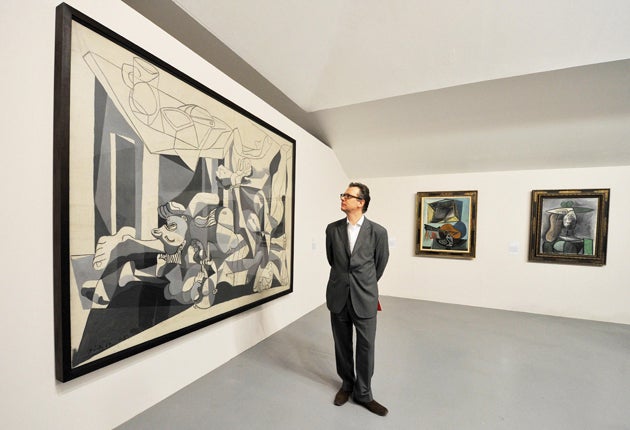Picasso: Peace and Freedom, Tate Liverpool, Liverpool
Picasso was a communist party member, but he would have been locked up for his art under Stalin

It's arguable that Pablo Picasso's most famous signature was appended not to the drawing of a minotaur or weeping woman but to a cheque, made payable for a million francs to a French miners' strike fund in 1948.
It's less the sum – around £50,000 in today's terms – that blows the mind than the timing. A year before, the Parti communiste français (PCF) had won most seats in the country's elections, an outcome so horrifying that the United States threatened to withdraw Marshall Aid. When, attended by Albert Camus, Picasso was sworn in as a party member in 1944, he delivered a short speech on the joys of communism. His special praise was kept for that beacon of liberty, Stalin's USSR. To describe his politics as vexed is only to tell the truth.
Which, as an exhibition at Tate Liverpool shows, is not the same thing as saying that Picasso was a Stalinist, or even a communist. As with the sad story of Anthony Blunt, we need to recall the context. By 1944, Picasso had lost not one homeland but two: his native Spain, overrun by Franco in 1936, and France, his adopted home, invaded by the Nazis in 1940. In both countries, communism offered the clearest focus for resistance, not just (or even principally) to the theories of fascism but to the horrors of its practice. Signing up to communism and being a communist were not necessarily the same thing, a paradox spelt out by the first work in this show.
Picasso began The Charnel House, on loan from MoMA in New York, shortly after taking the communist pledge. The work's ancestry obviously lies in Guernica, made seven years before. Like Guernica, The Charnel House shows the effects of war on ordinary people: it is taken from a photograph of a murdered Spanish Republican family. Like Guernica, too, The Charnel House is painted in shades of black and grey – not some abstruse Cubist experiment or reference to Netherlandish grisaille, but an echo of newsreel screens. "I am not a news photographer," Picasso would sniff, but he made work that looked like news photography even so. Whatever his aesthetic reasons for doing this, it is clear that he saw cinema as popular in a way that painting was not. The Charnel House is a depiction not just of the masses, but for the masses.
But does that make it communist, or even, in any useful sense, political? A thing that must be borne in mind as you walk around Picasso: Peace and Freedom is that there was a way of painting – Socialist Realism – that had, in 1932, been declared properly communist by no less influential a critic than Marshal Stalin. Had it toed the party line, The Charnel House would have been quite a different picture. As it was, Picasso harrumphed: "I don't teach the Russians about economics, so why should they teach me about painting?". And he carried on making the kind of formalist work that would almost certainly have had him sent to a gulag.
At the same time, he was, in the literal sense, a card-carrying communist. This left him with a moral conundrum. Picasso was, in 1944, well on the way to becoming the world's richest artist, one of his Harlequins selling for a stratospheric $12,000, more than covering the notorious miners' cheque. Being a communist sat uneasily with being a maker of luxury goods. And so Picasso, pre-empting his friend Coco Chanel, invented a diffusion range.
The works in this show run from the impossibly expensive – the canvas Woman in a Green Hat, say – to such insistently affordable objects as the posters and headscarves Picasso designed for the various peace congresses he attended. He also began to play around with modes of art-making seen as less elite, including ceramics and linocuts, and lithographs such as The Women of Algiers (1950). Along with chickens in their pots, the masses, or at least some of them, could have Picassos on their walls. One image in particular – the dove with the olive branch – became the property of the world.
But if Picasso's politics explain his fecundity, they also, by some Athenian irony, explain his wealth. The 48,000 objects he is known to have made may have let him sleep easier in his bed, but they made him ineluctably richer. And his communism? At Stalin's death in 1953, he drew a portrait of the deceased First General Secretary for the PCF's literary magazine, Les Lettres françaises, that was so obviously slapdash that it caused outrage among his fellow-members. The artist that emerges from Tate Liverpool's excellent show may be a sentimental socialist and certainly a humanitarian, but he is only ever an accidental communist. Thank goodness.
To 30 Aug (0151-702 7400)
Next Week:
Charles Darwent looks behind the plain brown wrapper of Tate Modern's peepshow, Exposed
Subscribe to Independent Premium to bookmark this article
Want to bookmark your favourite articles and stories to read or reference later? Start your Independent Premium subscription today.

Join our commenting forum
Join thought-provoking conversations, follow other Independent readers and see their replies
Comments